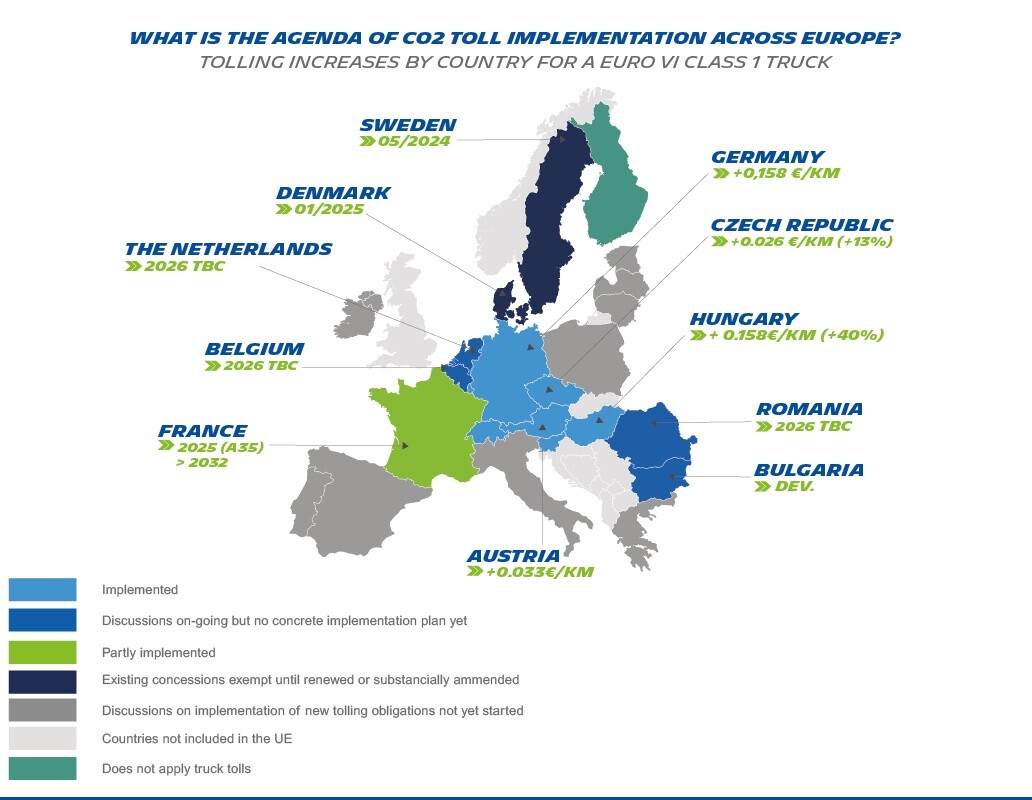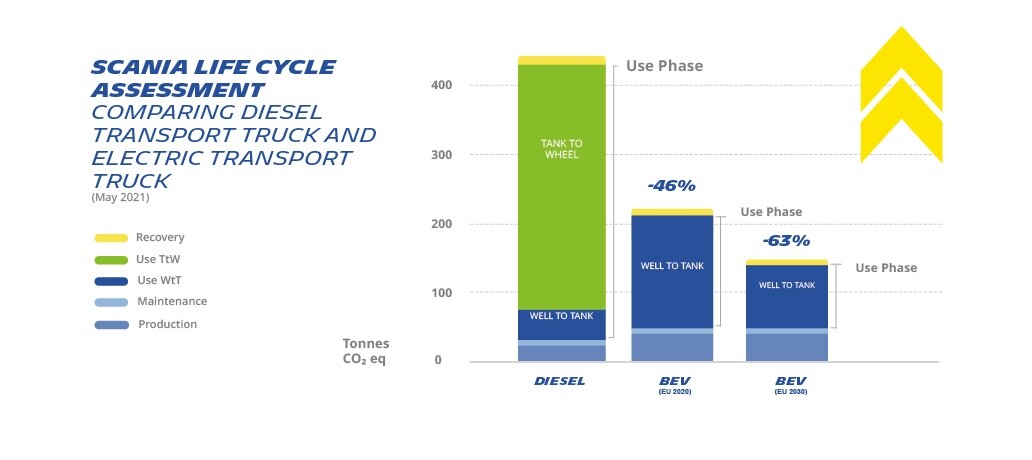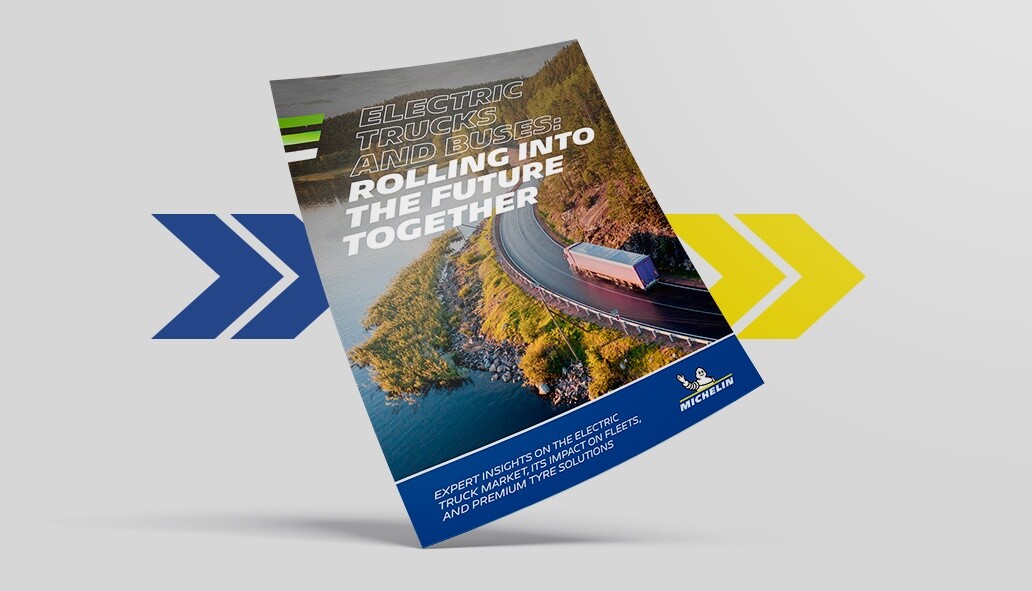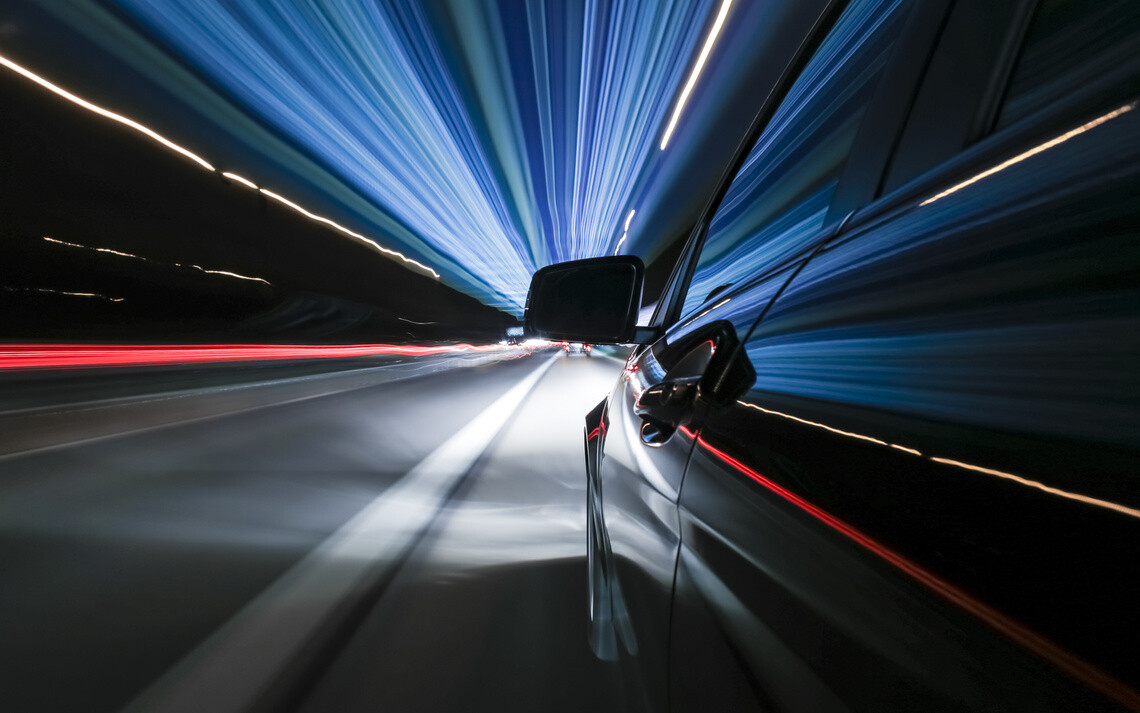
header understanding carbon footprint
Aerial view of the bridge and the road over the river Pinios in the green valley of Tempe in Greece
The words “carbon footprint” get thrown around a lot ౼ and for good reason! Our planet is warming, and collective, effective action is needed. By understanding the impact that internal combustion engines have on your truck’s carbon footprint, you can identify areas for improvement. Read on as we explore the benefits of sustainable fleet management ౼ it’s not just good for the planet, it can also be good for your business.
From start to finish: A breakdown of CO2 emissions throughout a truck’s lifecycle
Every truck, throughout its life, emits varying levels of CO2 at different stages. During the production phase, for example, at least 10,000 reported materials¹ are sourced and integrated into the truck itself ౼ from metals to rubber to plastics, each with its own carbon price tag. Once the truck hits the road, there are two key phases:
• Well-to-Tank (WTT): This covers the CO2 emissions from extracting, refining and delivering fuel (diesel for traditional trucks, battery charging for electric vehicles).
• Tank-to-Wheel (TTW): These carbon dioxide emissions from trucks are produced exclusively by combustion engines when the vehicle is in use (there are no tank-to-wheel CO2 emissions for electric trucks).
Best practices for an Internal Combustion Engine (ICE): How to reduce your truck’s carbon footprint
Fleet owners who haven't yet made the switch to BEVs still have very effective tools at their disposal to reduce their truck’s carbon footprint ౼ for the sake of the planet as well as their bottom line.
Assess and mitigate your transport fleet’s carbon footprint
Fleet owners can take meaningful steps to reduce their truck’s carbon footprint ౼ from running on an optimised/low consumption engine to installing better aerodynamics, Michelin's low rolling resistance tyres are another key element. By minimising energy wasted through tyre deformation, they contribute significantly to fuel efficiency. Additionally, going from a C tyre in rolling resistance labelling to a B-rated tyre can result in an average saving over the life of the tyre of 0.6 litres per 100 km². Finally, training drivers in eco-driving techniques like smooth acceleration and controlled braking can yield impressive results. These strategies don't just reduce environmental impact; they also benefit your bottom line. With fuel costs accounting for roughly 30% of your fleet's operating expenses³, maximising efficiency translates to significant financial savings.
Our trucking carbon footprint calculator
For starters, Michelin’s truck carbon footprint calculator helps identify improvement areas by analysing the impact of retreaded or regrooved tyres, providing crucial data for making eco-conscious decisions. While this tool won’t reduce carbon emissions from trucks on its own, it will help fleets understand emissions sources and help identify decisions that will lead to more sustainable fleet management.
A new era for truck emissions testing and evaluations
Taking place in Europe: EURO 7 Regulations
The European Union is taking a significant step toward cleaner roads with the introduction of Euro 7 regulations. This is the seventh iteration of these regulations, and for the first time, it will address not just tailpipe emissions and truck emissions testing that contribute to the truck carbon footprint, but also particle emissions from brakes and tyres.
Since the launch of Euro 1 in 1992, these regulations have been instrumental in reducing combustion particle emissions by a remarkable 95%. Euro 7, expected to take effect around 2031, builds on this success by setting new standards for particle emissions from braking systems and tyre wear.
Working towards cleaner air particle emissions testing
In addition to reducing your truck’s carbon footprint, it is vital to be aware of the importance of reducing particle emissions as well. To better understand how to lower these emissions, take a look below at where they come from in the first place.
Classic ICE Vehicles rely on friction brakes. When a truck slows down, brake pads press against the wheels, grinding them to a halt. This process creates tiny particles of brake pad material that get released into the air. Regenerative braking, standard in all battery electric vehicles (BEVs), uses electric motors switched into reverse mode to slow down the vehicle. The result? BEVs produce near-zero particle emissions from braking, significantly reducing their impact on air quality as well as the overall environmental impact.
While EURO 7 regulations will directly impact heavy duty vehicle and truck manufacturers (OEMs), their effects will be felt throughout the transport sector. Fleets, especially those working with companies with strong corporate social responsibility (CSR) commitments, may be required to adopt Euro 7 compliant vehicles to ensure sustainability across their entire supply chain. This marks a new era for cleaner roads and more sustainable fleet management.
How Taxes and Tolls are Shaping Fleets in Europe
The European Commission has introduced a new policy to incentivise fleets to adopt lower-emission trucks. Starting in December 2023, Germany implemented a toll system that factors in a truck's CO2 emissions. Under these regulations, Euro 6 trucks registered before July 2029 face an 80% increase in toll costs. However, trucks registered after July 2019 and equipped with emissions-reducing technology (efficient engines, robotic gearboxes, aerodynamic deflectors, and Class A tyres) enjoy a reduced toll rate; meanwhile, electric vehicles benefit from a toll-free policy.
The European Commission has urged other member states to adopt similar measures to tackle carbon emissions from truck fleets. Todate, Sweden, Denmark, Austria, Hungary and the Czech Republic have already implemented this directive4.

Some European countries have adopted measures to minimise truck’s carbon emissions
Source: IRU⁵
Taking place in North America: Los Angeles Port Authority’s Clean Truck Program
The Clean Truck Program was established in 2008, as an early and voluntary action in answer to State law concerning air pollution. All drayage trucks that visit Port of Los Angeles and Port of Long Beach terminals must comply with the Port’s Clean Air Action Plan. The objective is that the entire truck fleet will be zero-emission by 2035. While air pollution from harbour trucks has decreased by 90% since 2008, the Port went further and launched the Clean Truck Fund in 2022. All trucks that aren’t zero-emission must pay $10 to access terminals. Currently, all funds collected are used to acquire new zero-emission trucks.6
Taking place in South America: Brazil is looking to set-up “green diesel” targets
Brazil is currently proposing a “future fuel” program which aims to reduce emissions from trucks and buses. It sets targets for "green diesel," requiring 1% of Brazil's diesel supply to be green by 2027 and at least 3% by 2037. These targets are part of broader efforts to promote sustainable fuel use. The initiative seeks to significantly lower vehicle emissions over the next few decades.7
Moving towards sustainable fleet management
As existing options get greener and new technologies develop, fleet managers need to maintain a keen focus on their truck’s carbon footprint and continuously seek out ways to improve their sustainable fleet management practices.
Preparing for tomorrow: The transition towards an electric fleet
When it comes to the truck’s carbon footprint, BEVs and traditional ICE vehicles have a trade-off. When compared to ICE vehicles, BEVs produce nearly double the truck’s carbon emissions during production and over four times more during the wheel-to-tank (WTT) phase. But here lies the beauty of a BEV: throughout its lifetime, a BEV generates zero emissions during the tank-to-wheel (TTW) phase because it doesn’t burn fuel. What’s more, BEVs use regenerative braking, which captures energy when slowing down and puts it back into the battery, further reducing reliance on external sources. When all data is calculated, BEVs actually generate up to a 50% smaller truck carbon footprint.8

Diesel trucks VS electric trucks carbon emissions throughout their life cycle
SCANIA LCA Report May 2021
But to get the cleanest BEV experience possible, the source of its electricity matters.
Think of electricity generation as a spectrum, with clean sources, like hydro, solar, wind, biofuels, waste and nuclear at one end, and the heaviest pollution sources, like coal, on the other. Right now, the world relies more on those not-so-clean sources, which means there are still WTT emissions for BEVs.
Even with the current energy mix, BEVs are still cleaner than ICE vehicles. And as we move towards more renewable energy sources the WTT footprint of BEVs will shrink even further. In fact, a BEV powered exclusively by wind energy could have an 86% smaller carbon footprint.9

Michelin electric trucks and buses white paper: rolling into more sustainable fleet management strategies

logo step up
The transportation industry is navigating a range of evolving challenges, like driver shortages, inflation, and rising costs, and finds itself at the centre of the climate crisis. Michelin is committed to reducing the industry's environmental impact and believes sustainable practices can benefit both the environment and your business. STEP UP is Michelin’s global approach to support these efforts.
- 1. SCANIA LCA Report May 2021
- 2. Michelin OEM
- *0.8L is the average deviation (VECTO value) measured between 2 labelling letters (B compared to C) for a new tyre. Simulation of an average saving over the life of the tyre of 0.6 litres per 100 km between a B-class tyre and a C-class tyre, for a vehicle traveling 150,000 km per year, for a fleet of 50 vehicles, with an assumed price of €1.45 per litre.
- 3.Ducker worldwide report_ VEHICLE MAINTENANCE COSTS & PAINS_ Michelin Community – December 2017
- https://business.michelin.co.uk/blog/articles/reduce-your-fuel-consumption-by-using-energy-saving-truck-tyres
- 4. European Commission. Road charging (tolls and vignettes)
- https://transport.ec.europa.eu/transport-modes/road/road-charging_en
- 5. IRU Webinar, New Truck Toll Systems. User registration required. May 2024
- https://www.iru.org/resources/iru-library/new-truck-toll-systems-europe-what-you-need-know-full-webinar-replay
- 6. Port of Los Angeles Clean Truck Program
- https://www.portoflosangeles.org/environment/air-quality/clean-truck-program.
- 7. Fuel of Future Program - Invest in Brazil
- https://www.gov.br/mme/pt-br/assuntos/noticias/ministro-destaca-oportunidades-de-investimentos-no-setor-de-petroleo-a-empresas-estrangeiras-nos-eua/EUAOCTFUELOFFUTUREPROGRAM1.pdf
- 8-9. SCANIA LCA Report May 2021

gettyimages 930571046
car going fast on a road by night







